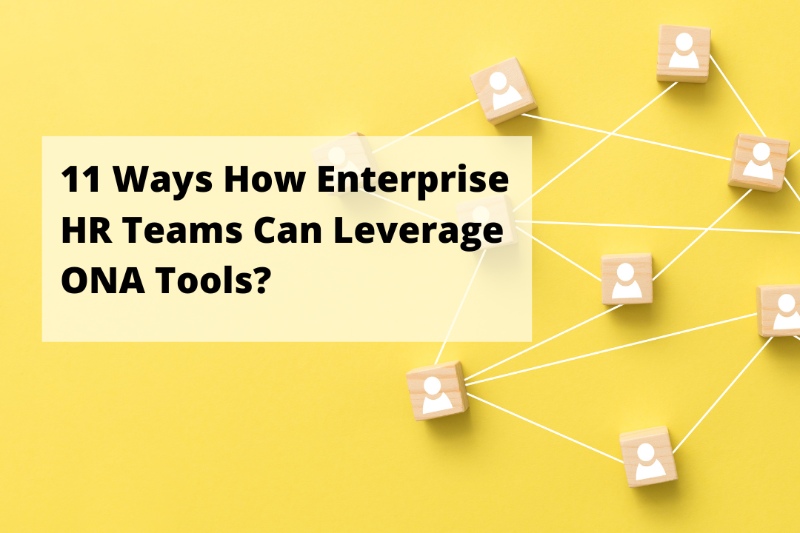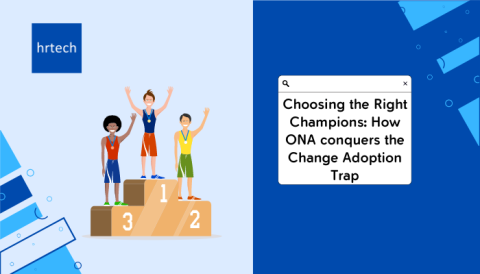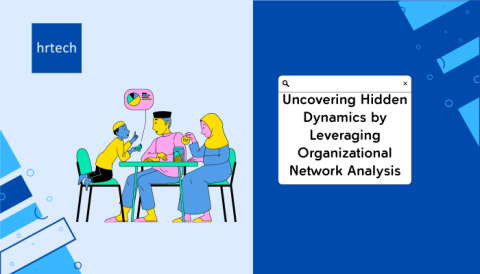ONA Tools, Market, Use cases and Case studies to help leaders uncover the hidden dynamics that drive performance by diving deep into the social capital of their organisation.

Organisational Network Analysis (ONA) helps you monitor and analyse formal and informal relationships in your organization. These insights can help you strategize business processes that maximize effective exchange of information and ideas that contribute towards sustainable business growth. ONA tools help organisations and leaders map organisation-wide interactions to discover people who create great energy and a sense of purpose at the workplace.
We list 11 ways Enterprise HR Teams can use ONA tools below:
Enhance Communication and Collaboration
ONA tools analyse digital interactions across various enterprise communication & collaboration systems on a real-time basis (using metadata). They help in assessing the levels of individual collaboration by analysing the relationships that individuals build within their team and the wider organization by giving insights via a visual representation on how effectively they are collaborating with each member of their network.
Consistent evaluation of collaboration between teams and departments or even across geographies can enable organisations to identify where there is greater collaboration or where silos exist.
Case Study: An Intergovernmental organisation used ONA tools (Fig. 1) to assess collaboration levels with external stakeholders and identify how the organization could benefit from more coordination between entities.
Fig. 1: Case Study- Intergovernmental organisation used ONA tools to assess collaboration levels. Source: Innovisor
Discover the Strengths & Weaknesses of Individuals & Teams & identify HiPOs
Organizational Network Analysis (ONA), like Cognitive Talent Solutions, can enhance the identification of high potential employees (HiPOs) by considering social capital metrics when assessing potential candidates.
The goal is to ensure that successful candidates are –
- High performers identified by their immediate supervisors and HR vetting process.
- Informal leaders identified by their peers.
Measure the Impact of Leadership Development Programs
Passive ONA tools can extract, process and analyse a wealth of previously invisible social capital data. These insights are presented in actionable reports that help participants to take appropriate action enabling them to improve their own work and leadership.
Tools like Trustsphere can capture key data points to share insights such as Leaders with larger networks of strong relationships, teams where manager communications are higher with direct reports that lead to increased team communication & collaboration (Fig. 2), employees with strong external relationships that reduce organisation silos and even larger volumes of emails outside working hours that can contribute to burnout.
Fig. 2: How managers communicate with their teams. Source: Trustsphere
Case Study: Trustsphere helped an FMCG client to measure the impact of a leadership development program. They gathered inputs by asking these questions – –
- What networks do our top leaders build?
- Are their behaviors changing?
- How does their leadership impact the people they lead?
Answers to these questions helped them achieve significant improvements like:
- 115% change in leaders’ own networks
- 38% increase in the number of working relationships with different business units
- 114% increase in the number of strong relationships
- 148% increase in strong relationships with employees at lower levels of the organizational hierarchy
- 40% improvement in their team’s levels of collaboration
Help in Organisation & Workplace Design Initiatives
By measuring team integration and collaboration, ONA tools can visualize the human capital aspects by identifying mediators & influencers that can be allocated projects or form Teams. By understanding how teammates are interacting, executives can ensure that critical teams are placed near each other to optimize productivity and office design decisions. Communication data can be used to measure the impact of an office redesign or expansion.
Bridge Gaps by Detecting Problems & Patterns of Misalignments
Organisational Network Analysis Tools can also determine where collaboration is misaligned with strategic goals and formal structure. Too often, well-intended collaboration efforts are counter-productive, sliding key employees into overload and leaving the most critical points of connection and collaboration understaffed or under-resourced. ONA tools can help organisations propel agility and uncover insights that help in aligning to business goals.
Identify Best-fit Resources for M&A Transitions & Interactions
Due to the high level of uncertainty, any delays in M&A transitions are likely to increase integration costs and impact the timeline. In this context, companies undergoing M&A activities can leverage the capabilities of organizational network analysis (ONA) to accelerate and inform decision-making, reduce uncertainty and maximize the success of their deals.
ONA Creates Value in Mergers and Acquisitions by –
1) Enhancing due diligence during the pre-deal stage
2) Reducing top talent attrition
3) Preventing cultural clashes
4) Accelerating realization of IT synergies
5) Monitoring integration effectiveness (Fig. 3).
Fig. 3: Monitoring collaboration between legacy organizations. Source: Cognitive Talent Solutions
Promote rapid innovation
Rapid innovation requires people, ideas, information and resources to flow across the organization. Prof Rob Cross shares that ONA Tools can be used to identify pockets of opportunity, drive innovation through hidden networks and engage others in ways that prompt risk-taking, co-creation and ownership.
Track Organisation and Employee Performance Management by Identifying Key Indicators
One of the potential benefits of relational analytics is to help nudge organisations get more insights on their workforce by integrating data from traditional sources of people and other sources like business productivity data etc.
It is becoming increasingly clear that integrating relational network data with traditional sources of HR, productivity and commercial data or people-enhanced data is the missing link to solving a universally accepted problem preventing companies from bridging the people data gap.
By identifying and tracking key indicators, relational analytics tools, like Panalyt, can help organisations drive customer centric agile transformations (Fig. 4), drive sales and operational efficiencies, accelerate change initiatives and accelerate post-merger integration amongst others.
Support Diversity & Inclusion Initiatives by Detecting Unconscious Bias from Interaction Behaviours
Organisations can adopt a data-driven approach by using People Analytics and more specifically, ONA tools to identify ways to counteract bias and promote diversity. While traditional D&I metrics have been effective in the level of DEI initiatives, they fail to measure the impact. Using passive ONA tools allows organisations to measure gender differences in networking behaviour(Fig. 5) , measure inclusion of diverse groups, identify hidden stars and detect unconscious bias.
Provides Insights into Change Initiatives :
By identifying key influencers and the flow of information in an organisation, culture change initiative can yield better results. ONA Tools like OrgMapper can pinpoint highly connected employees or influencers in the network. These influencers can be trained to work on a peer-to-peer basis in spreading the desired culture across the organisation.
Case study:An Irish Health care provider reveals the value and impact of engaging peer nominated colleagues(Fig. 6)
Map Employee Work Relationships and Patterns to help Companies Answer Critical Questions for Hybrid Work Planning
Hybrid work has gradually become the reality for many organisations as they are defining return-to-office strategies. Appropriately balancing remote and physical interactions stays the primary focus of these strategies.ONA helps leaders map employees’ working relationships and make data-driven decisions while planning return-to-office strategies.
A case example of a Biotech organisation published in MIT Sloan Review shows how these analytics dramatically shaped how leaders thought about bringing employees back for partial weeks. An intuition-led approach would otherwise have missed the large number of critical intergroup collaborations that would have been disrupted.
Conclusion
Effective communication is one of the key factors that contributes to a healthy work environment. This eventually translates into high employee motivation and productivity. The traditional and formal communication structures based on job roles and functional boundaries can sometimes fail to monitor and analyse complex interactions in the organisation. The revelation can be achieved through Organizational Network Analysis Tools.
ONA tools help you understand if the leaders support creativity, create a positive work environment and motivate the team to strive for excellence. With these tools, you can make data-driven decisions to create a positive impact on employees and the organisation as a whole.
References:
- Fig.1: Case Study- Intergovernmental organisation used ONA tools to assess collaboration levels. Source: Innovisor
https://www.innovisor.com/2019/05/14/from-individual-entities-to-coordination-and-reaped-synergies/ - Fig.2: Case Study: Measure the impact of a leadership development program. Source: Trustsphere
https://www.trustsphere.com/wp-content/uploads/2018/09/Leadership-201808-1-A4.pdf - ONA tools can help organisations propel agility by Prof. Rob Cross
https://www.robcross.org/network-strategies/propel-organizational-agility-and-alignment/ - Fig.3: ONA Creates Value in Mergers and Acquisitions by Francisco Marin
https://www.linkedin.com/pulse/5-ways-ona-creates-value-mergers-acquisitions-francisco-marin/ - Fig.5: Gender differences in Networking Behaviour . Source: Trustsphere.
https://www.trustsphere.com/measuring-diversity-and-inclusion-using-organizational-network-analysis/ - Fig.6: Case Study: Irish Healthcare Provider. Source: OrgMapper
https://orgmapper.com/community-resources-page/ - Optimizing Return-to Office strategies. Source: MIT Sloan Review
https://sloanreview.mit.edu/article/optimizing-return-to-office-strategies-with-organizational-network-analysis/
About the Author :

Swechha Mohapatra (IHRP-CP, Associate CIPD) is Head of Consulting & Delivery at hrtech.sg and has more than 9 years of global experience in various Talent functions. She is a passionate HRTech evangelist, a member of IHRP HRTech CoP Taskforce, and an avid learner who is certified Six Sigma-Green Belt with a background of MBA (Specialization in HR and IT) and Master’s in Labor Laws and Labor Welfare.



